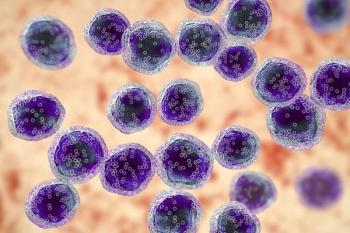
- ONCOLOGY Vol 19 No 2
- Volume 19
- Issue 2
Commentary (Cabanillas)-Follicular Lymphoma: Expanding Therapeutic Options
In their manuscript, Ganti et al tackle a very intricate and controversial subject: follicular non-Hodgkin’s lymphoma (NHL). The manuscript attempts to exhaustively cover multiple aspects of the disease, including pathology, prognostic factors, natural history, treatment of early-stage as well as advanced disease, relapsed disease, newer agents, monoclonal antibodies, interferon, radioimmunotherapy, stem cell transplantation, and future directions. To review all these topics thoroughly would almost require a textbook. To meticulously cover all of these aspects in a review article is a nearly impossible task. From my standpoint as a reviewer, to critique this article is an equally complicated task. I will therefore focus on only a few major issues.
In their manuscript, Ganti et al tackle a very intricate and controversial subject: follicular non-Hodgkin's lymphoma (NHL). The manuscript attempts to exhaustively cover multiple aspects of the disease, including pathology, prognostic factors, natural history, treatment of early-stage as well as advanced disease, relapsed disease, newer agents, monoclonal antibodies, interferon, radioimmunotherapy, stem cell transplantation, and future directions. To review all these topics thoroughly would almost require a textbook. To meticulously cover all of these aspects in a review article is a nearly impossible task. From my standpoint as a reviewer, to critique this article is an equally complicated task. I will therefore focus on only a few major issues. Historical Perspective
One piece that is sorely missing from this tour de force article is the historical angle required to put the 148 publications cited in proper perspective. One of the major developments in this field was the discovery, by Grever et al from Ohio State, that fludarabine (Fludara) is active in indolent NHL.[1] These data were subsequently expanded upon and confirmed by Redman from M. D. Anderson.[ 2] This led to a series of trials that culminated in the development of the FND regimen (fludarabine, mitoxantrone [Novantrone], dexamethasone), which was initially investigated as salvage therapy[3] and later in the front-line setting, where in combination with rituximab (Rituxan), it has so far yielded the highest clinical and molecular complete response rate of any combination for stage IV disease. In a randomized front-line study of concurrent or delayed rituximab added to FND, McLaughlin et al determined that simultaneous use was more effective in inducing molecular remissions. Unfortunately, the Ganti article does not discuss this. Instead, they focus on Zinzani's study of fludarabine and mitoxantrone, which is actually a modification of the FND regimen. In describing the Zinzani study, the authors make a brief reference to the polymerase chain reaction (PCR) test to assess molecular remissions. This new technique is increasingly being used to evaluate the quality of the remissions obtained in follicular lymphomas. Many patients with clinical complete responses are still found to have minimal residual disease when assessed by the PCR technique, and their prognosis is inferior to those who attain a molecular complete response. Role of Interferon
The contribution of interferon to the management of indolent NHL is another controversial subject, which is only superficially discussed. This agent was first discovered to have activity in NHL in the 1970s by Merigan et al[4] from Stanford, and these results were later confirmed at M. D. Anderson.[5] This led to its incorporation in 1982 as maintenance for stage IV low-grade NHL following induction chemotherapy with CHOPBleo (cyclophosphamide [Cytoxan, Neosar], doxorubicin HCl, vincristine [Oncovin], prednisone, bleomycin [Blenoxane]) at M. D. Anderson.[6] A recent analysis of these data shows that interferon maintenance was associated with improvement in failure-free survival and overall survival as compared with the CHOP-Bleo regimen. Subsequently, a randomized study by Solal-Celigny[7] and another by Hagenbeek[8] have confirmed the activity of interferon in prolonging failure- free survival (and in the first study, also overall survival). Ganti et al cite the Solal-Celigny article but mistakenly summarizes this important study in Table 3 as a randomized trial comparing fludarabine against chemotherapy plus interferon. Solal Celigny's study never included fludarabine. In addition, Ganti and coauthors neglect to discuss another important Southwest Oncology Group study by Fisher et al,[9] in which 571 patients treated with ProMACE-MOPP (prednisone, methotrexate, doxorubicin, cyclophosphamide, etoposide, mechlorethamine [Mustargen], vincristine, procarbazine [Matulane], prednisone) were then randomized to interferon maintenance vs observation. No advantage was found for interferon maintenance. Not only should these discrepant studies have been discussed, but an attempt should have been made to explain the incongruent data. There is no discussion about the fact that Fisher's study used a very toxic induction regimen, and that the MOPP regimen frequently requires dose reductions because of serious bone marrow toxicity. Subsequent tolerance to interferon can be seriously compromised by the induction regimen used, thus leading to suboptimal doses of interferon. It appears that an interferon dose below 3 million IU/m2 is inactive in low-grade NHL. Disease Curability
Finally, Ganti et al raise the complex issue of curability of indolent NHL. The definition of cure is quickly dismissed after stating that "it is very difficult to determine if clinical cure corresponds to complete elimination of all lymphoma cells." But is it really necessary to eliminate the last lymphoma cell to cure the patient? In a study of children with acute lymphoblastic leukemia, who were considered cured because they had been in complete remission for extended periods of time, rigorous techniques including PCR showed that residual evidence of leukemia cells is present in these patients. This finding suggests that the immune system is capable of dealing with minimal residual disease. In spite of these and other limitations of this review article, Ganti and colleagues have successfully summarized 148 publications in a single manuscript. Their conclusion, that "follicular lymphoma-long thought to be incurable- may soon have curative options, at least in a subset of patients" is one that I share and that in my opinion is already a reality, at least in part. Long-term follow-up of patients with stage IV indolent NHL treated at M. D. Anderson reveals that a plateau in survival is also reflected in the failure- free survival curve after approximately 8 years, suggesting that few relapses occur beyond that point.[10]
Disclosures:
Dr. Cabanillas owns stock in IDEC and is a speaker for Genentech.
References:
1. Grever M, Leiby J, Kraut E, et al: A comprehensive phase I and II clinical investigation of fludarabine phosphate. Semin Oncol 17(5 suppl 8):39-48, 1990.
2. Redman JR, Cabanillas F, Velasquez WS, et al: Phase II trial of fludarabine phosphate in lymphoma: An effective new agent in lowgrade lymphoma. J Clin Oncol 10:790-794, 1992.
3. McLaughlin P, Hagemeister FB, Romaguera JE, et al: Fludarabine, mitoxantrone, and dexamethasone: An effective new regimen for indolent lymphoma. J Clin Oncol 14:1262-1268, 1996.
4. Merigan TC, Sikora K, Breeden JH, et al: Preliminary observations on the effect of human leukocyte interferon in non-Hodgkin’s lymphoma. N Engl J Med 299:1449-1453, 1978.
5. Gutterman J, Blumenschein GR, Alexanian R, et al: Leukocyte interferon-induced tumor regression in human metastatic breast cancer, multiple myeloma, and malignant lymphoma. Ann Int Med 93:399-406, 1980.
6. McLaughlin P, Cabanillas F, Hagemeister FB, et al: CHOP-Bleo plus interferon for stage IV low-grade lymphoma. Ann Oncol 4:205-211, 1993.
7. Solal-Celigny P, Lepage E, Brousse N, et al: Doxorubicin-containing regimen with or without interferon alfa-2b for advanced follicular lymphomas: Final analysis of survival and toxicity in the Groupe d’Etude des Lymphomes Folliculaires 86 Trial. J Clin Oncol 16:2332- 2338, 1998.
8. Hagenbeek A, Carde P, Meerwaldt JH, et al: Maintenance of remission with human recombinant interferon alfa-2a in patients with stages III and IV low-grade malignant non- Hodgkin’s lymphoma. J Clin Oncol 16:41-47, 1998.
9. Fisher RI, Dana BW, LeBlanc M, et al: Interferon alfa consolidation after intensive chemotherapy does not prolong the progression- free survival of patients with low-grade non-Hodgkin’s lymphoma: Results of the Southwest Oncology Group randomized phase III study 8809. J Clin Oncol 18:2010-2016, 2000.
10. Liu Q, Fayad L, Hagemeister FB, et al: Stage IV indolent lymphoma: 25 years of treatment progress (abstract 1446). Blood 102:398a, 2003.
Articles in this issue
almost 21 years ago
Infectious Complications of Lung Canceralmost 21 years ago
Commentary (Harding/Bow): Infectious Complications of Lung Canceralmost 21 years ago
Commentary (Meltzer): The Role of PET-CT Fusion in Head and Neck Canceralmost 21 years ago
Follicular Lymphoma: Expanding Therapeutic Optionsalmost 21 years ago
Commentary (Longo)-Follicular Lymphoma: Expanding Therapeutic Optionsalmost 21 years ago
The Role of PET-CT Fusion in Head and Neck Canceralmost 21 years ago
The Application of Breast MRI in Staging and Screening for Breast Canceralmost 21 years ago
The Role of PET-CT Fusion in Head and Neck CancerNewsletter
Stay up to date on recent advances in the multidisciplinary approach to cancer.



















































































